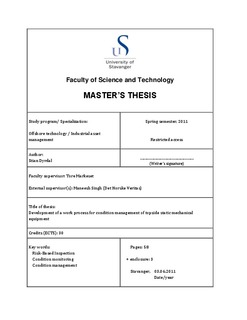| dc.description.abstract | Degradation and fatigue of static equipment is common in the offshore industry. The combination of saltwater, temperature, and humidity can significantly reduce the integrity of static process equipment, and thereby increase the possibility of failure. Condition monitoring and inspection of oil and gas production facilities are regularly performed to maximize availability, but the vast amount of data and imperfect results may be difficult to interpret.
Inspections on static process equipment are usually planned and executed based on risk-based principles, where risk is defined as a combination of consequence of failure (CoF) and probability of failure (PoF). This technique is called Risk-Based Inspection (RBI) planning. The inspection plans are based on the risk-evaluation and degradation rate calculated using base parameter values (e.g. flow rate, production, temperature, pressure). However, the values are static which gives a narrow view of the process since fluctuations of parameters are common at such production facilities.
Condition monitoring (CM) is a technique where the process condition is monitored either continuously or periodically. This technique monitors process parameters (e.g. temperature, pressure, flow rate, etc.) and feeds the user/onshore engineer with data regarding the equipment. The data collected may then be used to ascertain the possible rate of degradation mechanisms, which in turn can be used to calculate PoF, CoF and eventually risk.
A condition management system integrates the condition monitoring and risk-based inspection. The collection of live process parameters is integrated dynamically with the RBI analysis, optimizing the decision-making for inspection and maintenance planning of topside static mechanical equipment.
This thesis presents a work process for how a condition management system could be designed. It will give guidance on how information and data should be assessed and integrated to give the user/onshore engineer useful and effective support. | no_NO |
